The short term outlook from last analysis expected a short spike up to just above 2,467.57 and then a downturn. This is not what happened. Price has moved sideways in a small range suggesting a small Elliott wave triangle.
Summary: With the last wave up now looking very much like a three, have some confidence that primary wave 4 is underway. Look for price to move either sideways or lower with a lot of overlapping choppy movement for a few weeks.
In the short term, a quick spike up to just above 2,469.64 may be followed by a turn down to new lows.
Last monthly and weekly charts are here. Last historic analysis video is here.
ELLIOTT WAVE COUNT
WEEKLY CHART
Primary wave 3 now looks complete. Further and substantial confidence may be had if price makes a new low below 2,405.70, which is the start of minor wave 5 within intermediate wave (5). A new low below 2,405.70 may not be a second wave correction within an extending fifth wave, so at that stage the final fifth wave must be over. Fibonacci ratios are calculated at primary and intermediate degree. If primary wave 3 is complete, then it still exhibits the most common Fibonacci ratio to primary wave 1.
Primary wave 4 may not move into primary wave 1 price territory below 2,111.05.
Primary wave 4 should last about 8 weeks minimum for it to have reasonable proportion with primary wave 2. It is the proportion between corrective waves which give a wave count the right look. Primary wave 4 may last 13 or even 21 weeks if it is a triangle or combination. So far it may have completed its fourth week.
If primary wave 4 unfolds as a single or double zigzag, then it may find support about the lower edge of the maroon Elliott channel. If it is a triangle or combination, it may be more shallow, ending about mid way within the channel.
At this stage, the analysis gets complicated because there are several possible structures that primary wave 4 may be. The ideas for a triangle, combination, double zigzag, and single zigzag will be separated out into different daily charts in order for members to have a clearer picture of how price may behave for each. It is still impossible for me to tell you with any level of confidence which structure primary wave 4 may take, so all possibilities must be considered. I can only say that a single or double zigzag, or a triangle, would be most likely to exhibit good alternation with the flat correction of primary wave 2.
The daily charts are presented below in order of probability based upon my judgement.
The final target for Grand Super Cycle wave I to end is at 2,500 where cycle wave V would reach equality in length with cycle wave I. If price reaches the target at 2,500 and either the structure is incomplete or price keeps rising, then the next target would be the next Fibonacci ratio in the sequence between cycle waves I and V. At 2,926 cycle wave V would reach 1.618 the length of cycle wave I.
DAILY CHART – TRIANGLE
This first daily chart will illustrate how price might move if primary wave 4 unfolds as a triangle.
Intermediate wave (B) may possibly be complete at the high of the 1st of September. If it is complete there, then it would be a 0.86 length of intermediate wave (A), which is very close to the common range for triangle subwaves of about 0.8 to 0.85.
It is still possible that intermediate wave (B) may continue higher as a double zigzag. One of the five sub-waves of a triangle should be a more complicated multiple; most commonly that is wave C, but it may be any sub-wave. If intermediate wave (B) does continue higher, it may make a new all time high as in a running triangle. For the short term, if price makes a new high above 2,480.38, then a double zigzag continuing higher for intermediate wave (B) would be charted for the main daily wave count.
The triangle may still last a total of at least eight weeks, and possibly longer. If longer, then a Fibonacci 13 or 21 weeks may be expected.
Both intermediate waves (A) and (B) look like three wave structures.
If intermediate wave (B) is over, then intermediate wave (C) may be more complicated and time consuming than either of intermediate waves (A) or (B). Intermediate wave (C) may not move beyond the end of intermediate wave (A).
DAILY CHART – COMBINATION
A combination for primary wave 4 would still offer some alternation with the regular flat of primary wave 2. Whenever a triangle is considered, always consider a combination alongside it. Very often what looks like a triangle may be unfolding or may even look complete, only for the correction to morph into a combination.
There may only be one zigzag within W, Y and Z of a combination (otherwise the structure is a double or triple zigzag, which is very different and is considered below). At this stage, that would be intermediate wave (W), which is complete.
Combinations are big sideways movements. To achieve a sideways look their X waves are usually deep (and often also time consuming) and the Y wave ends close to the same level as wave W.
Here, intermediate wave (X) is very deep.
Intermediate wave (Y) may be a flat correction or a triangle. Within intermediate wave (Y), minor wave B may make a new high above the start of minor wave A as in an expanded flat or running triangle; this may include a new all time high. There is no upper invalidation point for a combination.
While intermediate wave (Y) may be a triangle, it is much more likely to be a flat correction. The combination of one zigzag and one flat within a combination is the most common by a very wide margin. A flat correction should be expected for intermediate wave (Y).
Within a flat correction, minor wave A must subdivide as a three, most often a zigzag and minor wave B must then retrace a minimum 0.9 length of minor wave A. Thereafter, minor wave C should move below the end of minor wave A. This structure may take another few weeks to complete.
DAILY CHART – DOUBLE ZIGZAG
While combinations and double zigzags are both labelled W-X-Y, they are very different structures.
Double zigzags (and very rare triples) belong to the zigzag family of corrections. Combinations are more closely related to flats (these are sideways movements). Double zigzags have a strong slope, as do single zigzags. The second zigzag exists when the first zigzag does not move price deep enough; its purpose is to deepen the correction.
To achieve a strong slope the X waves of double zigzags (and the very rare triple zigzags) are almost always brief and shallow. Here, intermediate wave (X) is neither brief nor shallow reducing the probability of this wave count.
Within the second zigzag, minor wave B may not move beyond the start of minor wave A.
It would still be possible for this wave count for primary wave 4 to end about the lower edge of the maroon channel on the weekly chart.
A channel is added about intermediate waves (W) and (X). For all three ideas at the daily chart level, if my labelling is correct, then any upwards movement at this stage should find very strong resistance at the upper edge of this channel. This channel is copied over to the hourly chart below.
HOURLY CHART
This hourly chart will suffice for all three daily charts above. All three daily charts see the last upwards movement as a complete zigzag for intermediate wave (B) or (X).
With a three down (labelled intermediate wave (A) or (W) ), and now a three up complete, some reasonable confidence may be had that this market is in a larger correction which is incomplete.
Minor wave B may be continuing further as a single zigzag. The wave upwards labelled minute wave a may be seen as either a three or a five. This analysis sees it as a five.
Minute wave b may be unfolding as a regular contracting triangle, but it may yet morph into a combination; both are sideways movements. When minute wave b is complete, then minute wave c may move price higher to end if it finds resistance at the upper edge of the black channel which is copied over from the daily chart. Minute wave c would be most likely to end at least slightly above the end of minute wave a, which has its high at 2,469.64, to avoid a truncation.
Referring to the larger structures at the daily chart level, the next wave downwards would be expected to be minor wave C within intermediate wave (C) for a triangle, or minute wave c within minor wave A for a combination, or minute wave iii within minor wave A for a double zigzag.
Intermediate wave (C) downwards within a triangle should unfold as a zigzag, subdividing 5-3-5.
Minor wave A downwards within a combination should unfold most likely as a zigzag subdividing 5-3-5, but it may also be a flat correction subdividing 3-3-5.
Minor wave A downwards within a double zigzag should unfold as an impulse: 5-3-5-3-5.
When minor wave B is complete, then targets for minor wave C downwards will again be calculated.
How low the next wave goes should offer some clues as to the larger structure of primary wave 4.
ALTERNATE WAVE COUNT
DAILY CHART
The first three daily charts all consider the possibility that the first wave down was a complete three. This alternate considers the possibility that a five down is still underway.
If intermediate wave (A) is an incomplete five down, then the larger correction for primary wave 4 would be a single zigzag.
Intermediate wave (A) may not now be an impulse, because the first wave down is clearly a three and not a five. It may be a leading diagonal.
Leading diagonals have sub-waves one, three and five that most commonly subdivide as zigzags, although they may also be impulses.
Within diagonals, the second and fourth waves must be zigzags and are commonly from 0.66 to 0.81 the length of the prior wave. Here, minor wave 2 would now be 0.86 the length of minor wave 1, not too much deeper than the common length.
Minor wave 3 must make a new low below the end of minor wave 1 below 2,417.35. It would most likely be shorter than minor wave 1, which was 73.52 points in length, as contracting diagonals are the most common variety.
Minor wave 2 may not move beyond the start of minor wave 1 above 2,490.87.
HOURLY CHART
Subdivisions at the hourly chart level are the same for all wave counts. Only the degree of labelling and the larger structure differ. All wave counts see a zigzag complete downwards to the last low, and now a zigzag upwards incomplete.
The most common type of leading diagonal is a contracting variety. In a contracting diagonal the third wave should be shorter than the first wave and the fifth wave shorter still, so that the third wave is not the shortest. If this leading diagonal is contracting, then minor wave 3 must move below the end of minor wave 1 at 2,417.35, and must end above 2,406.84 to be shorter than minor wave 1. When minute wave b may again be complete, then a target for minute wave c may again be calculated which should meet the conditions for the end of minor wave 3.
TECHNICAL ANALYSIS
WEEKLY CHART
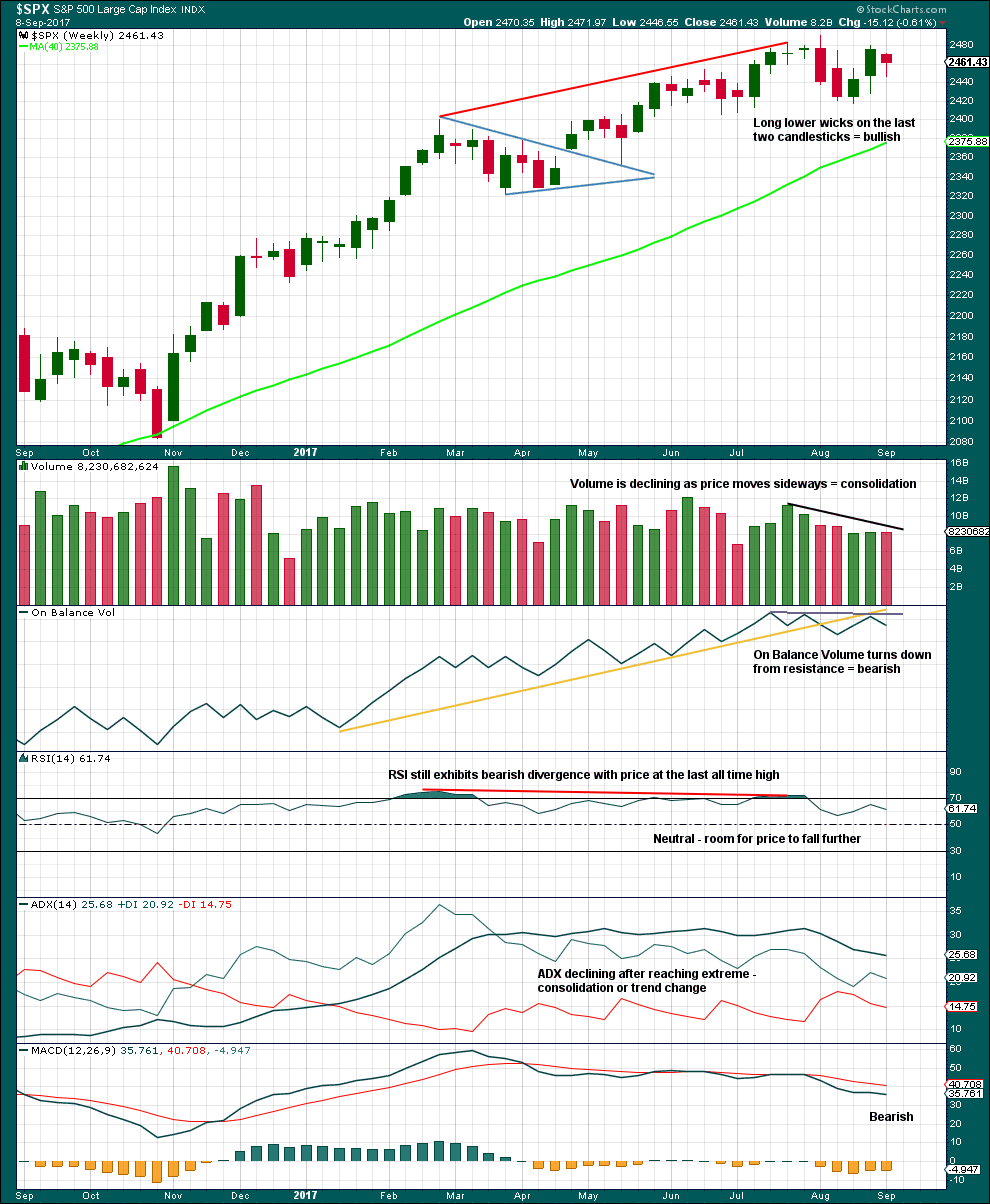
Click chart to enlarge. Chart courtesy of StockCharts.com.
An inside week closes red and the balance of volume was down. Volume shows a slight decline; during the week, the market fell very slightly of its own weight. This will be read as neutral; the slight decline in volume is very small.
Overall, this chart is bearish. Give reasonable weight this week to the bearish signal from On Balance Volume because it supports the Elliott wave counts.
DAILY CHART
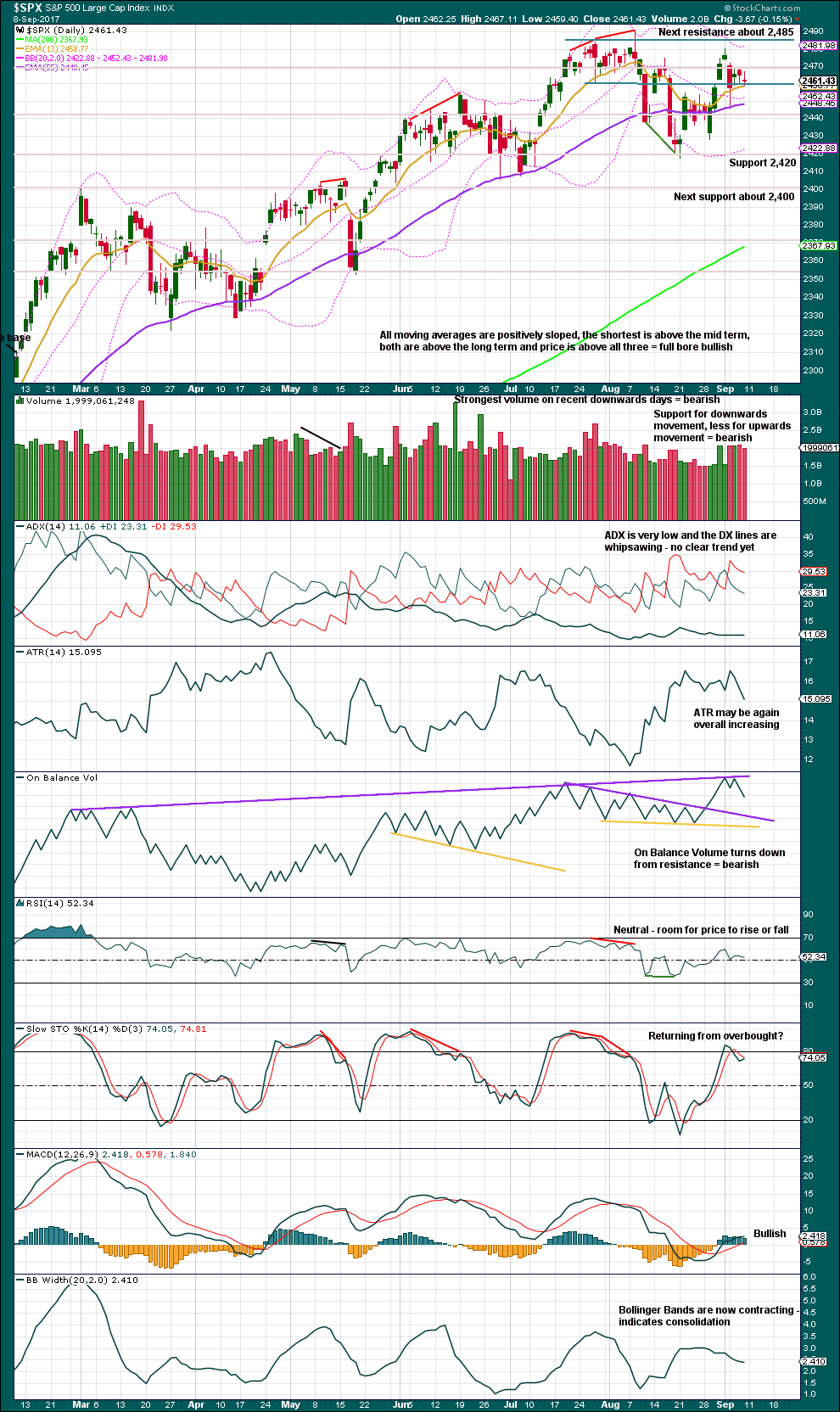
Click chart to enlarge. Chart courtesy of StockCharts.com.
Only if an upwards breakout to a new all time high is seen, which very importantly should have support from volume, would the view that price is consolidating have to change.
Thank you to our member Jimmy for pointing out the longer term trend line on On Balance Volume. On Balance Volume has turned down strongly from this line giving a bearish signal. Again, give this reasonable weight. It supports the Elliott wave counts and is one of the more reliable technical signals we use here at Elliott Wave Stock Market.
Price is still within a consolidation zone. Expect swings from resistance to support and back again. At this time, it looks like price may be ready to turn down close to resistance as Stochastics returns from overbought. Look for a downwards swing now to continue until price finds support about 2,420 and Stochastics reaches oversold.
Price does not move in straight lines within consolidations. It may also overshoot resistance or support before turning. Stochastics may remain overbought or oversold for a while; it is not an exact timing tool for price turns. This makes trading consolidations very risky. Typically, swing trading systems will have a series of small profits and a few large losses. Please manage risk carefully using my two Golden Rules:
1. Always use a stop.
2. Invest only 1-5% of equity on any one trade. Less experienced members should reduce that to 1-3%.
VOLATILITY – INVERTED VIX CHART
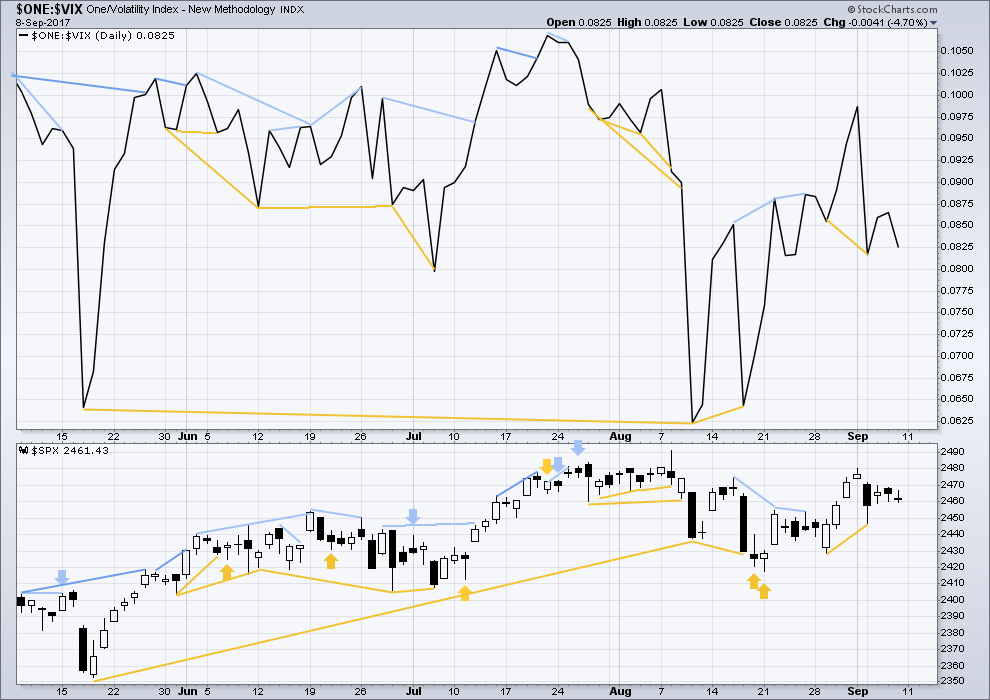
Click chart to enlarge. Chart courtesy of StockCharts.com.
Normally, volatility should decline as price moves higher and increase as price moves lower. This means that normally inverted VIX should move in the same direction as price.
There is no new divergence today between price and inverted VIX.
BREADTH – AD LINE
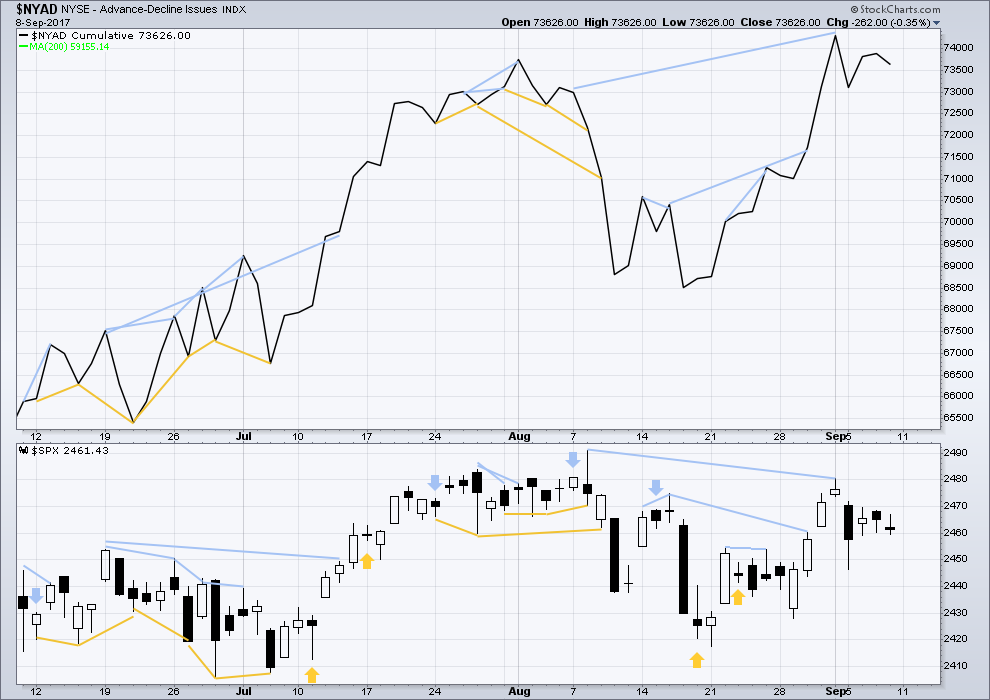
Click chart to enlarge. Chart courtesy of StockCharts.com.
With the last all time high for price, the AD line also made a new all time high. Up to the last high for price there was support from rising market breadth.
There is normally 4-6 months divergence between price and market breadth prior to a full fledged bear market. This has been so for all major bear markets within the last 90 odd years. With no divergence yet at this point, any decline in price should be expected to be a pullback within an ongoing bull market and not necessarily the start of a bear market.
There is no new divergence today between price and the AD line.
DOW THEORY
The S&P500, DJIA, DJT and Nasdaq have all made new all time highs recently.
Modified Dow Theory (adding in technology as a barometer of our modern economy) sees all indices confirming the ongoing bull market.
The following lows need to be exceeded for Dow Theory to confirm the end of the bull market and a change to a bear market:
DJIA: 17,883.56.
DJT: 7,029.41.
S&P500: 2,083.79.
Nasdaq: 5,034.41.
Charts showing each prior major swing low used for Dow Theory are here.
Published @ 11:45 p.m. EST on 9th September, 2017.

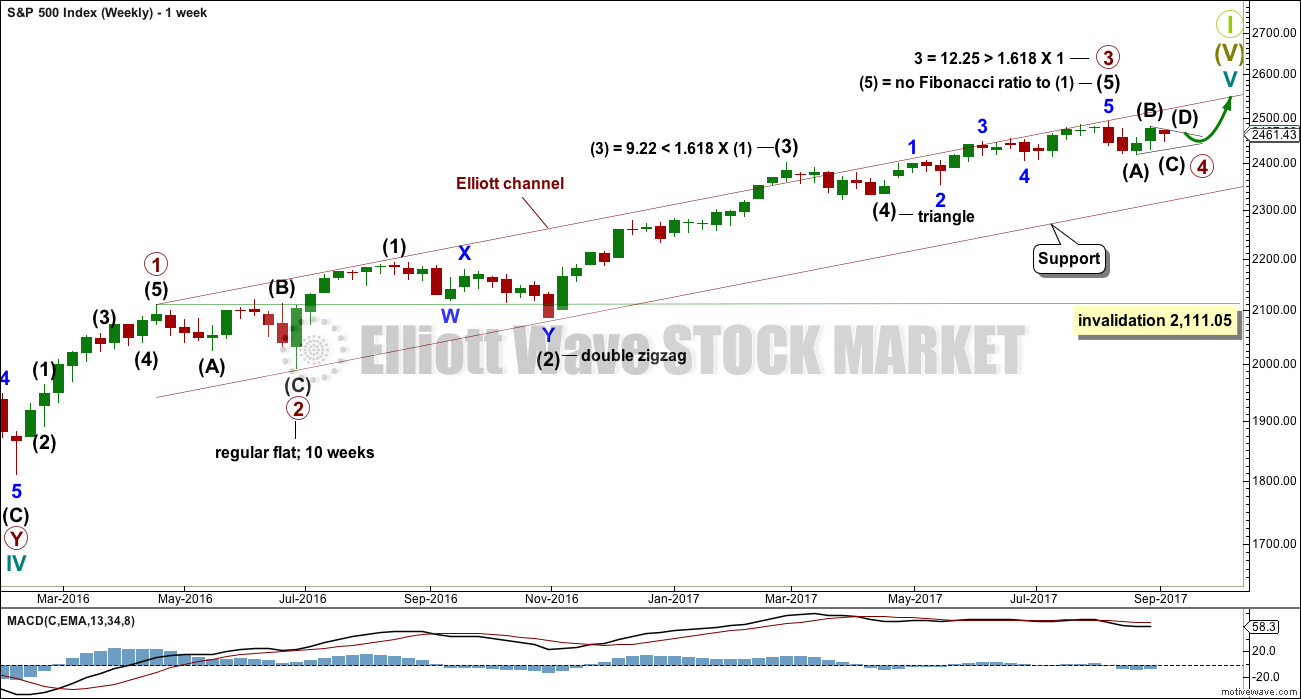
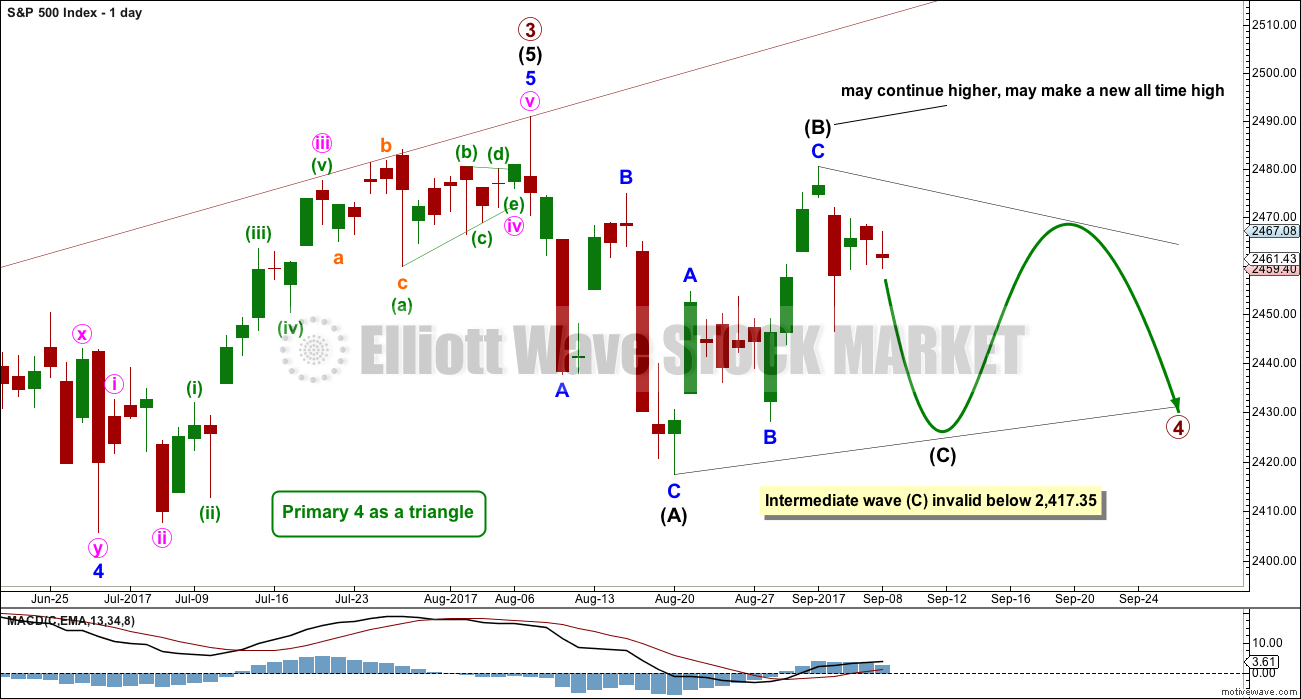
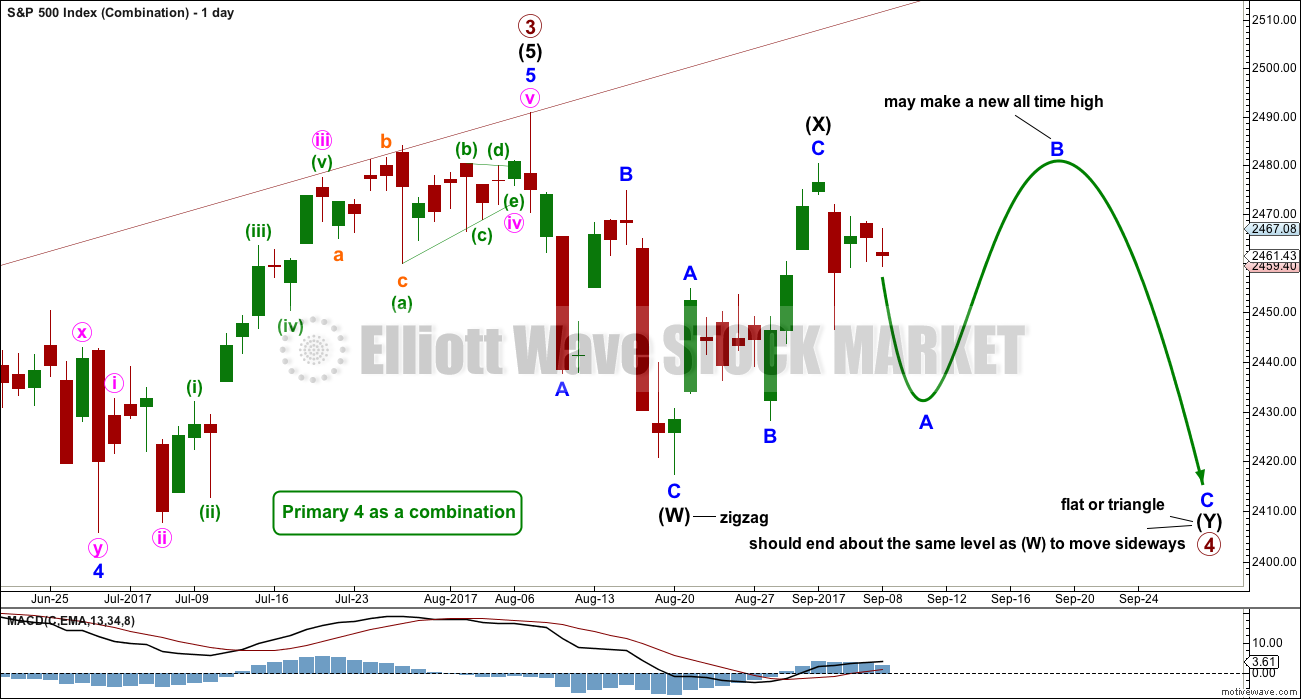
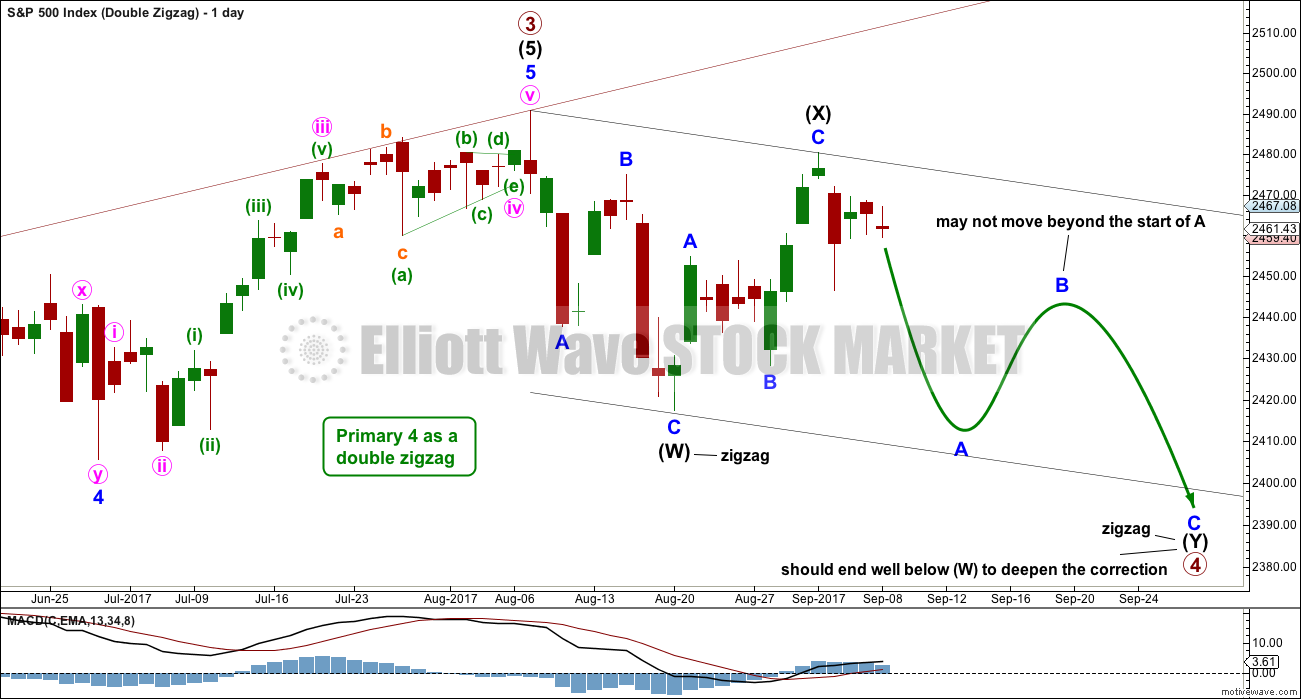
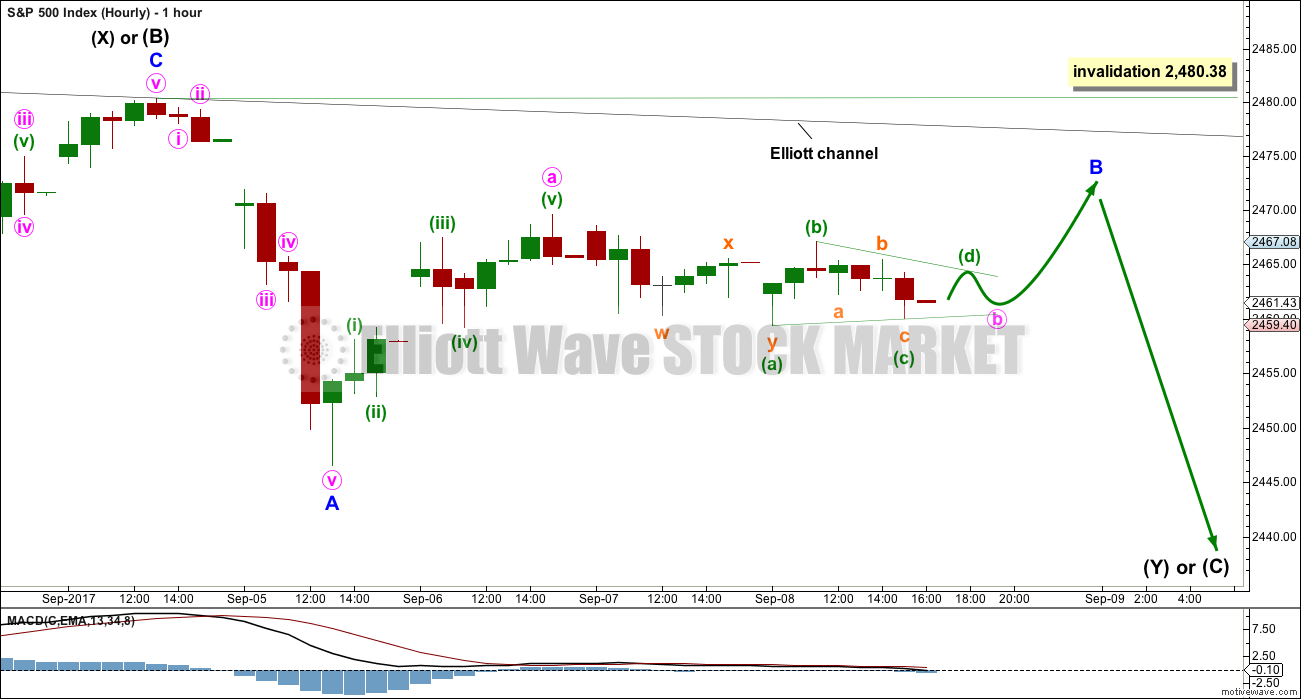
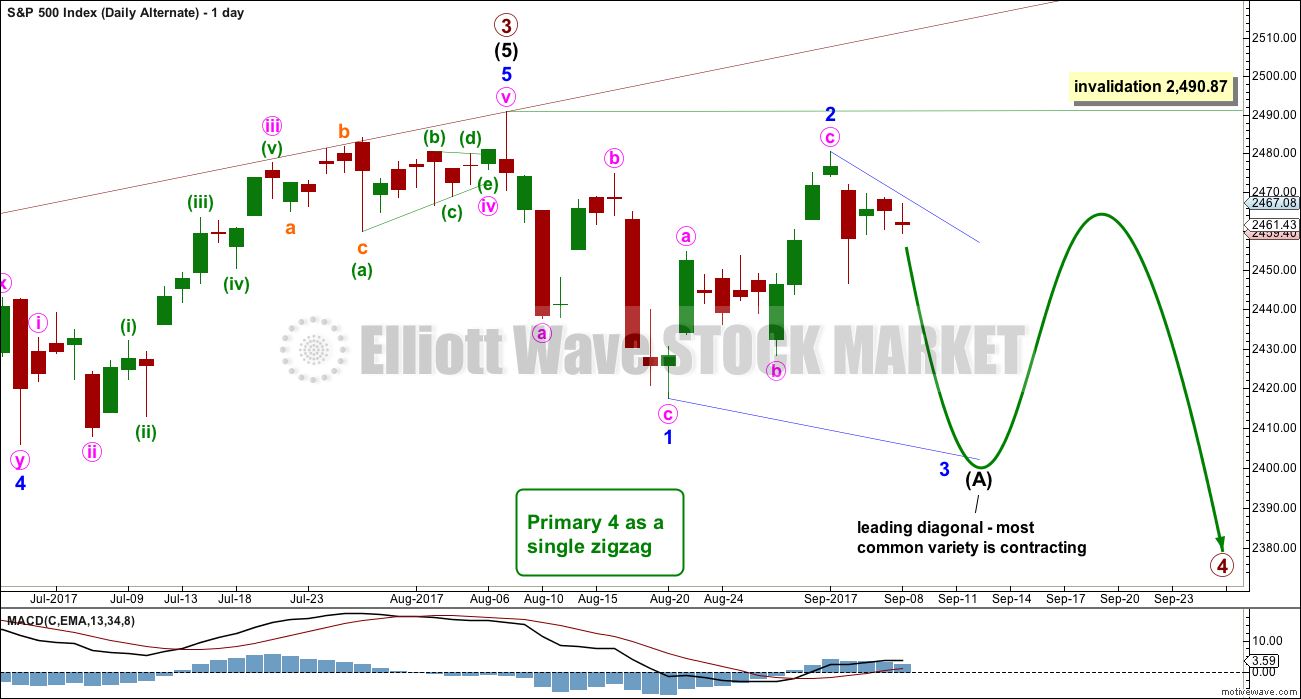
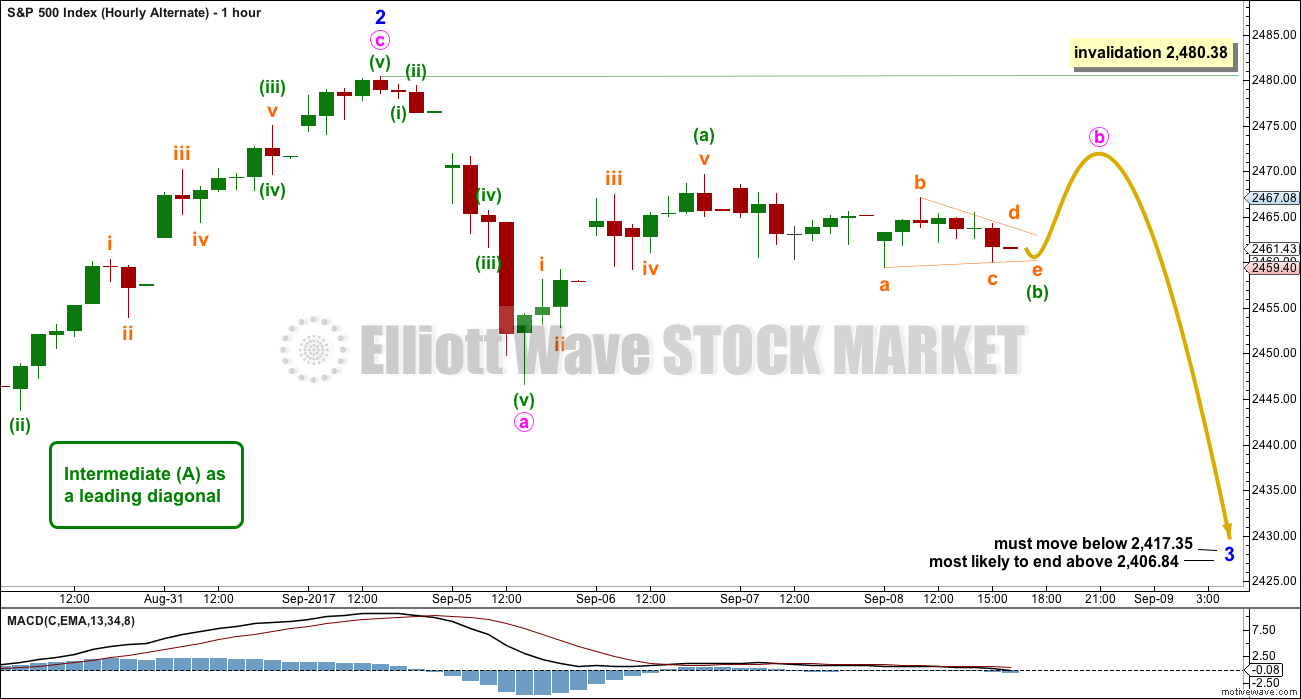
I do have to say that I find it quite frustrating that some members from time to time appear to not be taking risk management advice.
I have noted clearly that price is most likely within a large consolidation, and that it may include a new ATH before this upwards swing is done and the next swing down begins.
That is the nature of consolidations.
I have noted that only experienced members should be attempting to trade this. The rest of us should exercise patience. I have noted that less experienced members should be reducing position size to no more than 3% of equity, and be prepared for losses.
The multiple EW counts illustrate the multitude of possibilities in how price may travel through this consolidation.
If any members experience large losses here then please take that as a lesson to manage risk more carefully. Consider any losses as $$ paid for learning.
And finally, I’ll be adding to Terms and Conditions that any members found to be trading without stops (particularly) and / or trading any more than 5% of equity may find their membership cancelled. I am that serious about risk management, and I’m not prepared to try and give investment advice to anyone who chooses to ignore it. Because it has never worked out well in the past for me or them.
Boy did I get a pleasant surprise today. I discovered I was hanging onto 25 SPY 249 strike call contracts from a bearish call spread I had partially closed for a nice profit last week and completely forgot about. Spreads can sometimes be the gift that keeps on giving! Good to be even more nicely hedged than I had realized… Go SPX!!! Hit 2500.00!!! 🙂
🙂 Nice one Verne. The digital equivalent I guess of checking an old jacket pocket and finding a wad of cash you’d stashed there last season….
I found some cash today. So I too am happy.
I wish I could say it was a brilliant hedging decision but the truth is I had absolutely no expectation at the end of last week that SPX would run up 26 points this week, much less on Monday, and put those calls left for dead squarely in the money!
It was a great reminder of the importance of being hedged, even when trading with the trend. Considering all the ambushes we have seen the banksters pull over the years, I really should not be at all surprised by today’s action. I know a lot of bears were sent scrambling for cover this morning. Drinks on me everybody! 🙂
Volume today is lighter than the last two red daily candlesticks. So the rise in price today was not supported by volume and so should be approached with suspicion.
I like the idea we are continuing higher in the Intermediate X wave. It could bring us some strong negative divergences. We could go through 2500 to shake loose any bears holding on to short positions only to reverse hard and go back beneath 2470 to get the ball rolling downhill again. Just a possibility.
we have som divergence today with price and Stochastics, looks pretty typical to see near the end of an upwards swing within a larger consolidation
The October 20 215 strike diamond puts I sold for around 2.25 are STILL trading for 1.13 ask. Will continue to hold for a clear resumption of down-trend, or BTC order at 0.75 filled, which ever arrives first.
Bye all! 🙂
Adding October 20 40.00 strike KBE puts for 0.65.
We have come back to just about the underside of the prior support shelf, now acting as strong resistance. This topping pattern is as clear as they come, and this almost 2.5% ramp today as part of the global pump adheres to the theatre of the absurd.
A close above 42.30 says I am mistaken.
A double zigzag continuing higher? If this upwards wave is a B wave, it can be any corrective structure. Double zigzags are fairly common. This fits.
There’s no indication it’s over yet though, hence the ? at todays high.
Use the confidence point and the channel to indicate when there’s been a trend change.
Can you provide an alternate that has P3 continuing to the 2950 target you calculated from a while back?
Dreaming a Dream…
I’m not saying it’s particularly likely, I would just want to know what it looks like and whether it can be reconciled with any of the price action we’ve seen in the June and August pullbacks. We may very well be in a combination or triangle but I don’t think it’s completely out of the question P3 could be extending to the next fibonacci ratio. Unless earnings unexpectedly nosedive there are very few catalysts for a downturn through the end of the year (other than the always-present risk of a black swan).
The next key market signal will be a clean downward slice through the 50 day SMA. I am holding upside hedges until the bears execute…it should be decisive with no pauses or bounces as price approaches the line…
Verne what is ur target for the hedges or is it case of getting out when a trendline breaks to the downside
I am using 2470 as a critical pivot for the near term trend. I will probably sell my SPY 249 calls at the open tomorrow and hold the 212/215 bullish diamond call spread until we break back below 2470….
Perhaps the assumption that Primary Wave 3 was over should be re-examined.
there is another possibility to consider here and that is we might be in a final wave 5!
Could be, but Primary 2 lasted 10 weeks – if Primary 4 is over is only lasted 2.
Primary 4 isn’t over. Or, if it is, it never happened and the larger count gets revised. Possible. Much more likely we’ll get a turn (even after a new ATH) and get a fresh bout of down and sideways and down. It’s almost Fall of 2017, historically a major bear period in the market, and EW is still saying it will be too.
I have considered that and discarded it based upon very poor proportion with P2. As Olga says, P2 lasted 10 weeks. If P4 is over it lasted only 2. That just looks all wrong.
Hi all new on here , where is this likely to end, short from friday
I think we are in the Daily alternate with Minor 2 not yet finished. This should presage a deeper fall.
Could be a double zig zag X wave of Primary 4 instead of Minor 2 if we get a new ATH (which would mean your Minor 1 would be W with Y down still to go to complete Primary 4)
Day of destroying wave counts!
It only looks that way. That is exactly what this kind of money dump is intended to do. One rarely sees this kind of price action in a normal bull market advance, and the effects of these kinds of mania tend to be ephemeral…we will see….
An overall up move symmetric with the 6/29 low to 8/8 high puts a decision point at around 2502.50. The 1.27% extension of that same low-high is in the 2513 area. If it doesn’t turn at the ATH…then I’ll be looking for a turn in that range, 2502-2513. Will take several days at least if it gets there.
It is looking to me like this move today is already exhausted. The banksters are going to have to spend a lot more money, a LOT more…to move price beyond the upper B band just overhead…
We have been saying this for weeks, and every time, the “banksters” come out on top. We thought P4 started in June, but then kept on going up. Now the putative P4 beginning for August is looking suspect. We are 5 points from another ATH. The only possibility now is a combination…
I agree new highs appear likely, but a second wave not eliminated before…
Today’s ramp clearly globally co-ordinated with DAX and Nikkei also up quite a bit…interesting….
or a running triangle, fairly common structures.
Jimmy one of the great advantages of having expert EW analysis is that it takes the emotion out of trading decisions. Every now and then over the years price action has invalidated all the current counts but that is a very rare event indeed. Most importantly, there is a number that specifically tells you that the preferred count is incorrect, and in my experience all the years I have been trading using Lara’s analysis, you will be far better off assuming her analysis is correct until and unless price action says that it is not. Also pay very close attention to her price targets. The market can, and often does meander on its way there but more often than not, her targets are spot on. Hope that helps to alleviate the anxiety a bit! 🙂
A move back below 5960 by NDX 100 spells trouble for the giddy bulls….
The hammer on VIX suggests others are buying this dip. Loaded rest of contracts at 3.80…
Opened contingent order to close short side of put spread with any SPX move back below 2470.00. If that happens to day we will shed 100 SPX points in a hurry…
SPX is a 20 Trillion dollar market.
The banksters also will learn that trading against the trend will have the same result for them as it does for the retail trader…. 🙂
I remain entirely un-impressed.
The volume profile is suspect.
They can pump all they want. They will have to go to new all time highs to erase the significant technical damage inflicted the last few weeks. I think we are in a deep second wave correction, which means this primary correction is going a lot lower before we put in the final wave up. SPX has traded back to an area of substantial resistance and the bulls have yet to contend with a response from the bears. Let’s see how they close out the session.
We could be seeing some furious short-covering underway.
Nonetheless, I am glad I held on to my bullish put spreads, tempted as I was to close them out on Friday. The banksters are SO predictable. I will continue to hold spreads, while loading up on October 18 VIX 10.00 strike calls for 3.75 per contract; 1/2 full position.
Will add second half if/when bid goes to 4.00 per contract.
Presumably we are in C wave of minor B of either a expanded flat or running triangle.
For expanded flat targets would be 2482 at 1.05xA, 2488 and 2493 for 1.236 and 1.382xA respectively.
Or the wave count is wrong and we are blasting toward SPX 3000…
Alternatively, many moves go to the 1.27 (1.618^2) external retracement of the prior move (the prior C wave on the chart I posted). I have that at 2494.21.
Boom!!! I guess everyone on wall street is back on the job, time to buy. Seems like the last hope for bears is this is a C wave of the second of a double zig-zag (with a veeeery shallow B). I’m just taking it as it comes, and right now, the long side is the right side. ps: your’s truly published in the NYTImes today!!! Last letter in the opinion/letters section (paper and print), check it out! (sorry for the spam…)
This??
Yep – that’s pretty much the count I am using right now unless we make a new ATH. I’ve just opened a 50% short with stop at ATH – very low risk here if I’m wrong.
I’m looking at Aug 14-16 and considering that as a possible model of the action here. In which case, a double top at the ATH would be likely. Too much upward momentum for me to short here yet.
An almost touch on the ATH, and a turn down on the 5 minute breaking the 21 EMA. I’ve taken a very small short to get started here, but will bail on a break of the ATH.
Higher swing high now on SPX 5 minute chart, on top of the day’s big push…discretion the better part of valor, taking my tiny loss and sitting on the sidelines.
I agree, this too is how I’m seeing it.
The problem though with stops at the ATH is that it could be breached, only for price to turn down again. If (B) is of a running triangle, or if (A) is unfolding as an expanded flat and this upwards wave is B of that.
But because there’s no upper invalidation point for either of those ideas, setting a stop at the ATH seems reasonable. Money management rather than EW may be the best decider of where to place stops.
Breaking 2481 is no small matter. We have a potential 1-2, i-ii up from the 2417 lows on August 21st.
Somebody primes the pump every time we have a terrorist attack or natural disaster.my guess is the working group. Unbelievable. Here we go again.
Looks to me like “Sound & Fury…”
I might think differently had the assault by ES on the 2470 pivot been less pathetic. No change whatsoever to the larger context of a primary correction underway. I am shorting the pump…
So far so good… it’s not invalidated until it’s invalidated. And it has to be invalidated during NY session hours as that’s what the wave count uses.
Still… if the invalidation point is indeed passed after hours, then IME it does tend to lead to an invalidation during hours.
I have seen pics of the devastation on Tortola. Not looking so good Verne. Glad you are okay, and we are wishing that your home is recoverable too.
The damage on the island is indeed extensive. Thankfully our ICF buildings held up remarkable well. I think this was the most intense sustained winds I have ever seen an ICF structure endure. I have to say I was amazed at how many
very nice buildings did not have hurricane shutters, including the main government building in road town. I was also observing with some consternation how many very expensive homes had used 2X4 framing for the their roof rafters. Even the ones with metal roofs were peeled open like a sardine can. I am betting that even an improvement to 2×6 would have allowed bigger bolts that might have saved quite a few roofs. I am starting to think about heading down there to help out where I can. A lot of friends had their homes seriously damaged by the combination of wind and water intruding into broken windows. Thanks so much for your well wishes. Folk down there are going to need a lot of help.
Lara does the overnight futures price action count when we are looking at your figures or do we just count it from the actual trading hours. Markets overnight much higher due to no news from Korea
WOW. Futures are in blast off mode. All the indices (Asia, Europe futures, American futures) are rocking in sync like we haven’t seen in months. Literally all open index futures are DEEP in the green. This action is like the Sunday after the French elections in April. I will reserve my final judgement until I see what happens at the open, but we may very well blast through the upper edge of Lara’s channel over the next two days. The analysis does call for a upwards break from the triangle and then a steep decline, but I really don’t think that’s what we’re seeing here. Largely due to the fact that the previous flag breakout & drop-off was intraday (August 9) and came on weak upside volume. Unless there is a sell off at the open this move will be rather convincing. Complete capitulation by the bears, who were apparently banking on more missiles this weekend.
The way things are going we may even gap above the channel. It is not out of the question we see an ATH by Tuesday.
Possibly.
But it’s not over until the fat lady sings. And ATM she’s asleep.
Thanks Lara. Your analysis pointing out several possibilities for this 4th wave is helpful. I am sure it is not easy identifying and analyzing so many counts. Then we add in the flat-lined SPX of Friday to complicate it even further. Your work is much appreciated. Thanks.
You’re most welcome Rodney.
It is relatively easy for me to identify the possibilities, less easy to decide which to publish and which to not publish. How many charts? The possibilities often feel endless.
Not so easy to try and communicate the myriad possibilities with clarity.
Clear as mud? 🙂
Verne – following on from the same thread on the 6th of September – KBE has indeed broken a critical support level. And in the last few days looks to have backtested resistance at prior support.
Longer standing members by now all know my favourite trade set up. And as Verne says, “you know what to do”. Go short people! Go short!
But for goodness sake, manage risk.
Edit: in the last one day, Friday, it looks to have backtested.
Thanks for the confirmation Lara. Chart indeed showing a very nice topping process. I am holding October 40/42 bearish credit call spreads , which is a great way to limit risk (limited to 200 per cpntract if KBE ttading above 42 at expiration). That chart suggests those spreads could possibly be rolled for compounding profits over the next few months. 😉
I took some SKF (inverse financials fund). Following orders…lol!!!
Chris – you asked a question on 6th September about BKK –
Yes, it looks to me like nested 1-2 X 5
BUT
It could also be a continuation of a correction that began back on the 18th of May. It could be a flat and the nesting you see could be a B wave upwards.
And further Chris – I really hope you make it out of Irma okay! (getting a wave is a bonus 🙂 )
Thanks Lara, we got really pounded. Roads blocked by debris, trees down, minor flooding and no power. Nothing catastrophic, so we are thankful for that.
First! The doc’s string is broken!